Fale sobre as duas bibliotecas de código aberto Disruptor e Aeron

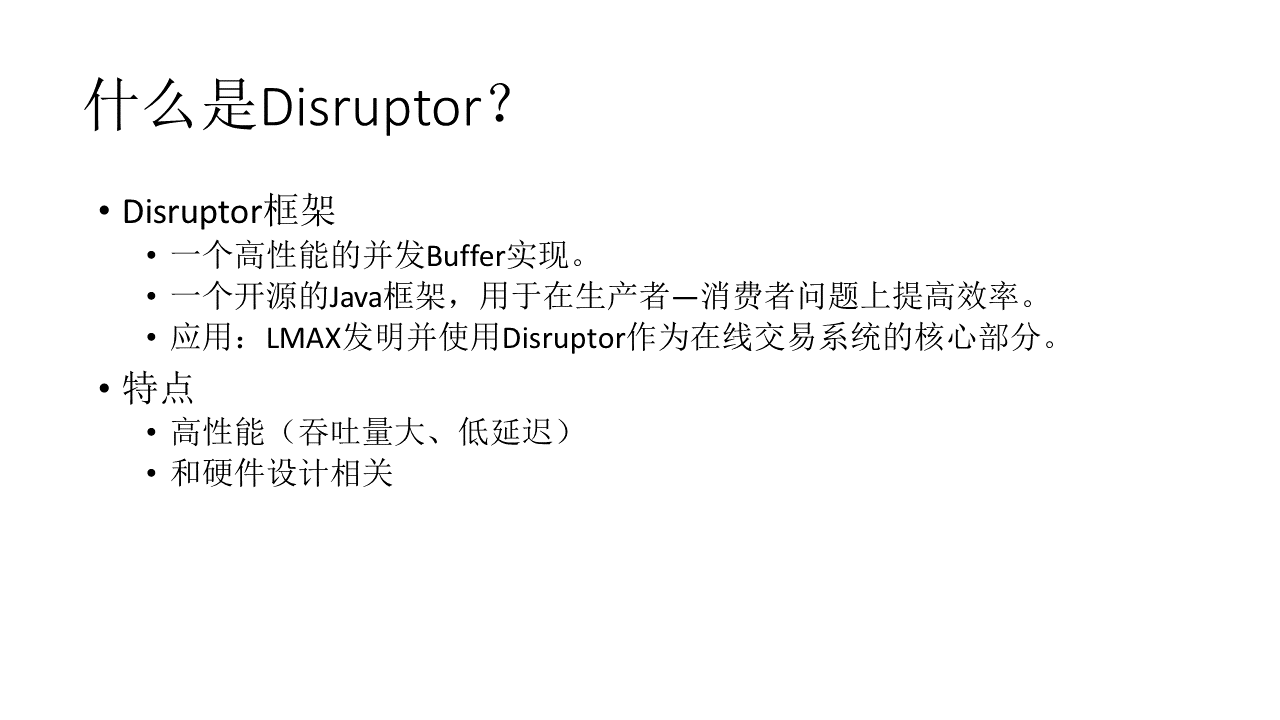

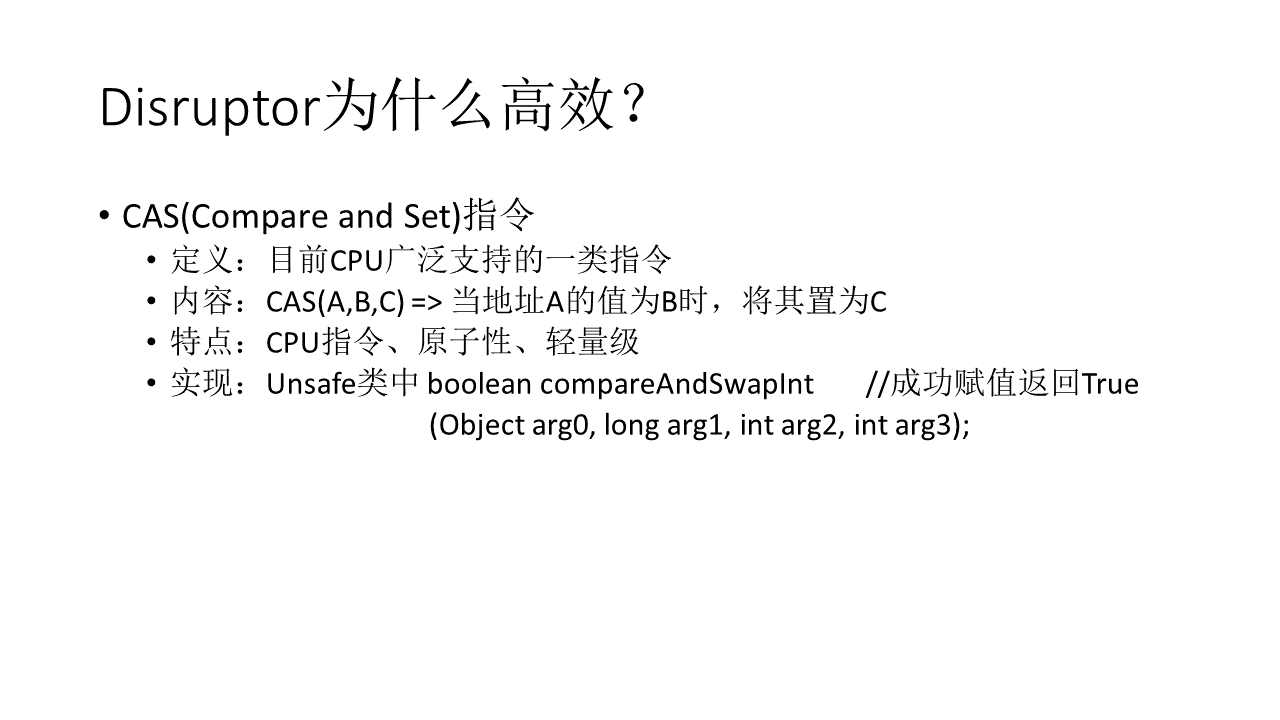
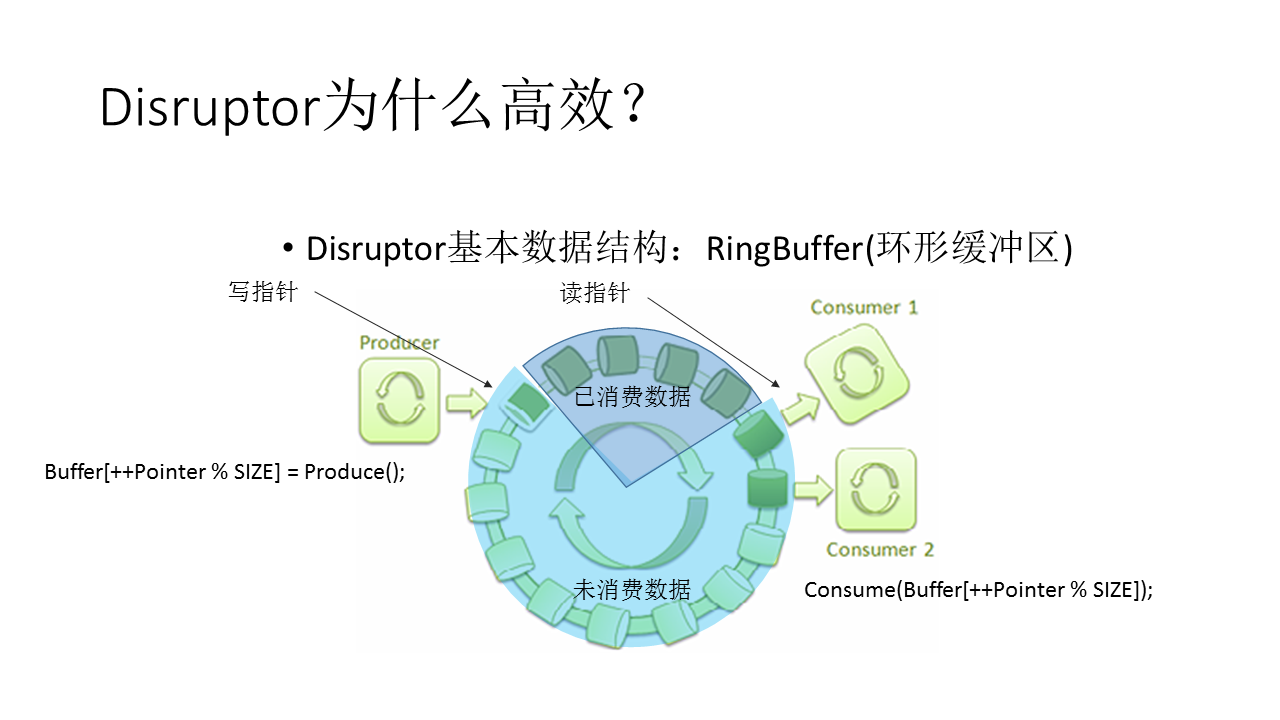
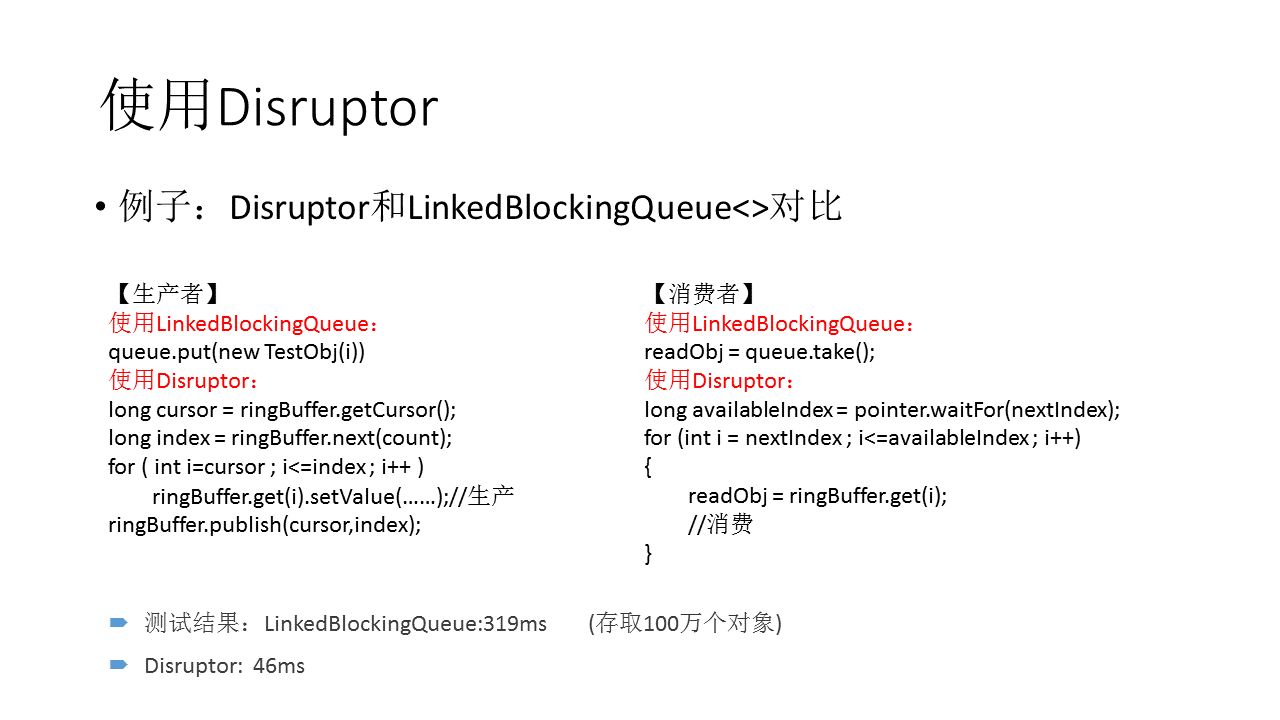
Disruptor
A melhor maneira de entender o que é o Disruptor é compará-lo a algo bem entendido e com um objetivo bastante semelhante. No caso do Disruptor, esse seria o BlockingQueue do Java. Como uma fila, o objetivo do Disruptor é mover dados (por exemplo, mensagens ou eventos) entre threads dentro do mesmo processo. No entanto, existem alguns recursos principais que o Disruptor fornece que o diferenciam de uma fila. Eles são:
• Eventos de difusão seletiva para consumidores, com gráfico de dependência do consumidor.
• Pré-aloque memória para eventos.
• Opcionalmente, sem travas.
Conceitos principais
Antes de entendermos como o Disruptor funciona, vale a pena definir vários termos que serão usados em toda a documentação e no código. Para aqueles com um DDD dobrado, pense nisso como a linguagem onipresente do domínio Disruptor.
• Ring Buffer: o Ring Buffer é frequentemente considerado o principal aspecto do Disruptor; no entanto, a partir de 3.0, o Ring Buffer é responsável apenas pelo armazenamento e atualização dos dados (Eventos) que se movem pelo Disruptor. E, para alguns casos de uso avançados, pode ser completamente substituído pelo usuário.
• Sequência: o Disruptor usa Sequências como um meio para identificar onde um componente específico está fazendo. Cada consumidor (EventProcessor) mantém uma Sequência, assim como o próprio Disruptor. A maioria do código simultâneo depende do movimento desses valores de Sequência; portanto, a Sequência suporta muitos dos recursos atuais de um AtomicLong. De fato, a única diferença real entre os 2 é que a Sequência contém funcionalidade adicional para impedir o compartilhamento falso entre Sequências e outros valores.
• Sequenciador: o seqüenciador é o núcleo real do disruptor. As 2 implementações (produtor único, produtor múltiplo) dessa interface implementam todos os algoritmos simultâneos usados para a passagem rápida e correta de dados entre produtores e consumidores.
• Barreira de sequência: a barreira de sequência é produzida pelo seqüenciador e contém referências à sequência publicada principal do sequenciador e às sequências de qualquer consumidor dependente. Ele contém a lógica para determinar se há algum evento disponível para o consumidor processar.
• Estratégia de espera: A estratégia de espera determina como um consumidor aguardará os eventos serem colocados no disruptor por um produtor. Mais detalhes estão disponíveis na seção sobre como ser opcionalmente sem trava.
• Evento: a unidade de dados transmitida do produtor para o consumidor. Não há representação de código específica do evento, conforme definido inteiramente pelo usuário.
• EventProcessor: o loop principal de eventos para manipular eventos do Disruptor e possui a propriedade Sequence do consumidor. Existe uma única representação chamada BatchEventProcessor que contém uma implementação eficiente do loop de eventos e retornará uma implementação fornecida usada da interface EventHandler.
• EventHandler: uma interface que é implementada pelo usuário e representa um consumidor para o Disruptor.
• Produtor: este é o código do usuário que chama o Disruptor para enfileirar eventos. Este conceito também não tem representação no código.
Aeron
Aeron é um transporte OSI de camada 4 para fluxos orientados a mensagens. Ele funciona em UDP ou IPC e suporta unicast e multicast. O objetivo principal é fornecer uma conexão eficiente e confiável com uma latência baixa e previsível. A Aeron possui clientes Java, C ++ e .NET.
Quando usar?
A high and predictable performance is a main advantage of Aeron, it’s most useful in application which requires low-latency, high throughput (e.g. sending large files) or both (akka remoting uses Aeron).
If it can work over UDP, why not to use UDP?
The main goal of Aeron is high performance. That is why it makes sense why it can work over UDP but doesn’t support TCP. But someone can ask what features Aeron provides on top of UDP?
Aeron is OSI Layer 4 (Transport) Services. It supports next features:
1. Connection Oriented Communication
2. Reliability
3. Flow Control
4. Congestion Avoidance/Control
5. Multiplexing
Architecture
Aeron uses unidirectional connections. If you need to send requests and receive responses, you should use two connections.Publisher and Media Driver (see later) are used to send a message, Subscriber and Media Driver — to receive. Client talks to Media Driver via shared memory.
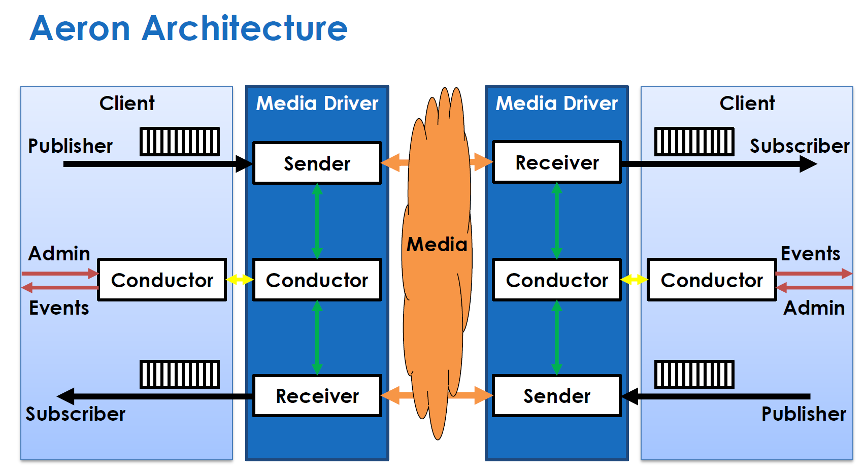
为什么将这两个库在一起聊呢,通常Disruptor框架的核心数据结构circular buffer是Java实现的,主要原因是Java对并发的支持比较友好,而且比较早的支持了内存模型,但是 C++ 11以后,C++ 同样在并发方面有了长足的进步, Aeron就是在这个背景下产生的,虽然核心代码依旧是Java,但是在对C++客户端支持的设计中也实现了比较多的,有价值的数据结构,比如OneToOneRingBuffer, ManyToOneRingBuffer。
下面就以OneToOneRingBuffer为例进行说明,
/* * Copyright 2014-2020 Real Logic Limited. * * Licensed under the Apache License, Version 2.0 (the "License"); * you may not use this file except in compliance with the License. * You may obtain a copy of the License at * * https://www.apache.org/licenses/LICENSE-2.0 * * Unless required by applicable law or agreed to in writing, software * distributed under the License is distributed on an "AS IS" BASIS, * WITHOUT WARRANTIES OR CONDITIONS OF ANY KIND, either express or implied. * See the License for the specific language governing permissions and * limitations under the License. */ #ifndef AERON_RING_BUFFER_ONE_TO_ONE_H #define AERON_RING_BUFFER_ONE_TO_ONE_H #include <climits> #include <functional> #include <algorithm> #include "util/Index.h" #include "util/LangUtil.h" #include "AtomicBuffer.h" #include "Atomic64.h" #include "RingBufferDescriptor.h" #include "RecordDescriptor.h" namespace aeron { namespace concurrent { namespace ringbuffer { class OneToOneRingBuffer { public: explicit OneToOneRingBuffer(concurrent::AtomicBuffer &buffer) : m_buffer(buffer) { m_capacity = buffer.capacity() - RingBufferDescriptor::TRAILER_LENGTH; RingBufferDescriptor::checkCapacity(m_capacity); m_maxMsgLength = m_capacity / 8; m_tailPositionIndex = m_capacity + RingBufferDescriptor::TAIL_POSITION_OFFSET; m_headCachePositionIndex = m_capacity + RingBufferDescriptor::HEAD_CACHE_POSITION_OFFSET; m_headPositionIndex = m_capacity + RingBufferDescriptor::HEAD_POSITION_OFFSET; m_correlationIdCounterIndex = m_capacity + RingBufferDescriptor::CORRELATION_COUNTER_OFFSET; m_consumerHeartbeatIndex = m_capacity + RingBufferDescriptor::CONSUMER_HEARTBEAT_OFFSET; } OneToOneRingBuffer(const OneToOneRingBuffer &) = delete; OneToOneRingBuffer &operator=(const OneToOneRingBuffer &) = delete; inline util::index_t capacity() const { return m_capacity; } bool write(std::int32_t msgTypeId, concurrent::AtomicBuffer &srcBuffer, util::index_t srcIndex, util::index_t length) { RecordDescriptor::checkMsgTypeId(msgTypeId); checkMsgLength(length); const util::index_t recordLength = length + RecordDescriptor::HEADER_LENGTH; const util::index_t requiredCapacity = util::BitUtil::align(recordLength, RecordDescriptor::ALIGNMENT); const util::index_t mask = m_capacity - 1; std::int64_t head = m_buffer.getInt64(m_headCachePositionIndex); std::int64_t tail = m_buffer.getInt64(m_tailPositionIndex); const util::index_t availableCapacity = m_capacity - (util::index_t)(tail - head); if (requiredCapacity > availableCapacity) { head = m_buffer.getInt64Volatile(m_headPositionIndex); if (requiredCapacity > (m_capacity - (util::index_t)(tail - head))) { return false; } m_buffer.putInt64(m_headCachePositionIndex, head); } util::index_t padding = 0; auto recordIndex = static_cast<util::index_t>(tail & mask); const util::index_t toBufferEndLength = m_capacity - recordIndex; if (requiredCapacity > toBufferEndLength) { auto headIndex = static_cast<std::int32_t>(head & mask); if (requiredCapacity > headIndex) { head = m_buffer.getInt64Volatile(m_headPositionIndex); headIndex = static_cast<std::int32_t>(head & mask); if (requiredCapacity > headIndex) { return false; } m_buffer.putInt64Ordered(m_headCachePositionIndex, head); } padding = toBufferEndLength; } if (0 != padding) { m_buffer.putInt64Ordered( recordIndex, RecordDescriptor::makeHeader(padding, RecordDescriptor::PADDING_MSG_TYPE_ID)); recordIndex = 0; } m_buffer.putBytes(RecordDescriptor::encodedMsgOffset(recordIndex), srcBuffer, srcIndex, length); m_buffer.putInt64Ordered(recordIndex, RecordDescriptor::makeHeader(recordLength, msgTypeId)); m_buffer.putInt64Ordered(m_tailPositionIndex, tail + requiredCapacity + padding); return true; } int read(const handler_t &handler, int messageCountLimit) { const std::int64_t head = m_buffer.getInt64(m_headPositionIndex); const auto headIndex = static_cast<std::int32_t>(head & (m_capacity - 1)); const std::int32_t contiguousBlockLength = m_capacity - headIndex; int messagesRead = 0; int bytesRead = 0; auto cleanup = util::InvokeOnScopeExit { [&]() { if (bytesRead != 0) { m_buffer.setMemory(headIndex, bytesRead, 0); m_buffer.putInt64Ordered(m_headPositionIndex, head + bytesRead); } }}; while ((bytesRead < contiguousBlockLength) && (messagesRead < messageCountLimit)) { const std::int32_t recordIndex = headIndex + bytesRead; const std::int64_t header = m_buffer.getInt64Volatile(recordIndex); const std::int32_t recordLength = RecordDescriptor::recordLength(header); if (recordLength <= 0) { break; } bytesRead += util::BitUtil::align(recordLength, RecordDescriptor::ALIGNMENT); const std::int32_t msgTypeId = RecordDescriptor::messageTypeId(header); if (RecordDescriptor::PADDING_MSG_TYPE_ID == msgTypeId) { continue; } ++messagesRead; handler( msgTypeId, m_buffer, RecordDescriptor::encodedMsgOffset(recordIndex), recordLength - RecordDescriptor::HEADER_LENGTH); } return messagesRead; } inline int read(const handler_t &handler) { return read(handler, INT_MAX); } inline util::index_t maxMsgLength() const { return m_maxMsgLength; } inline std::int64_t nextCorrelationId() { return m_buffer.getAndAddInt64(m_correlationIdCounterIndex, 1); } inline void consumerHeartbeatTime(std::int64_t time) { m_buffer.putInt64Ordered(m_consumerHeartbeatIndex, time); } inline std::int64_t consumerHeartbeatTime() const { return m_buffer.getInt64Volatile(m_consumerHeartbeatIndex); } inline std::int64_t producerPosition() const { return m_buffer.getInt64Volatile(m_tailPositionIndex); } inline std::int64_t consumerPosition() const { return m_buffer.getInt64Volatile(m_headPositionIndex); } inline std::int32_t size() const { std::int64_t headBefore; std::int64_t tail; std::int64_t headAfter = m_buffer.getInt64Volatile(m_headPositionIndex); do { headBefore = headAfter; tail = m_buffer.getInt64Volatile(m_tailPositionIndex); headAfter = m_buffer.getInt64Volatile(m_headPositionIndex); } while (headAfter != headBefore); return static_cast<std::int32_t>(tail - headAfter); } bool unblock() { return false; } private: concurrent::AtomicBuffer &m_buffer; util::index_t m_capacity; util::index_t m_maxMsgLength; util::index_t m_headPositionIndex; util::index_t m_headCachePositionIndex; util::index_t m_tailPositionIndex; util::index_t m_correlationIdCounterIndex; util::index_t m_consumerHeartbeatIndex; inline void checkMsgLength(util::index_t length) const { if (length > m_maxMsgLength) { throw util::IllegalArgumentException( "encoded message exceeds maxMsgLength of " + std::to_string(m_maxMsgLength) + " length=" + std::to_string(length), SOURCEINFO); } } }; }}} #endif
使用示例
AtomicBuffer ab(&buff[0], buff.size()); OneToOneRingBuffer ringBuffer(ab); util::index_t tail = 0; util::index_t head = 0; ab.putInt64(HEAD_COUNTER_INDEX, head); ab.putInt64(TAIL_COUNTER_INDEX, tail); std::cout <<"circular buffer capacity is : "<<ringBuffer.capacity() << std::endl;
util::index_t length = 24; util::index_t recordLength = length + RecordDescriptor::HEADER_LENGTH; AtomicBuffer srcAb(&srcBuff[0], srcBuff.size()); srcAb.putInt64(0, 999); srcAb.putStringWithoutLength(8, "0123456789012345"); while (ringBuffer.write(MSG_TYPE, srcAb, 0, length)) { } int timesCalled = 0; const int messagesRead = ringBuffer.read( [&](std::int32_t msgTypeId, concurrent::AtomicBuffer& internalBuf, util::index_t valPosition, util::index_t length) { timesCalled++; std::cout << "circular buffer read value is : " << internalBuf.getInt64(valPosition)
<<" string value: " << internalBuf.getStringWithoutLength(valPosition+8, length - 8) <<" called times: "<< timesCalled <<std::endl; });
运行结果
circular buffer capacity is : 1024 circular buffer read value is : 999 string value: 0123456789012345 called times: 1 circular buffer read value is : 999 string value: 0123456789012345 called times: 2 circular buffer read value is : 999 string value: 0123456789012345 called times: 3 circular buffer read value is : 999 string value: 0123456789012345 called times: 4 circular buffer read value is : 999 string value: 0123456789012345 called times: 5 circular buffer read value is : 999 string value: 0123456789012345 called times: 6 circular buffer read value is : 999 string value: 0123456789012345 called times: 7 circular buffer read value is : 999 string value: 0123456789012345 called times: 8 circular buffer read value is : 999 string value: 0123456789012345 called times: 9 circular buffer read value is : 999 string value: 0123456789012345 called times: 10 circular buffer read value is : 999 string value: 0123456789012345 called times: 11 circular buffer read value is : 999 string value: 0123456789012345 called times: 12 circular buffer read value is : 999 string value: 0123456789012345 called times: 13 circular buffer read value is : 999 string value: 0123456789012345 called times: 14 circular buffer read value is : 999 string value: 0123456789012345 called times: 15 circular buffer read value is : 999 string value: 0123456789012345 called times: 16 circular buffer read value is : 999 string value: 0123456789012345 called times: 17 circular buffer read value is : 999 string value: 0123456789012345 called times: 18 circular buffer read value is : 999 string value: 0123456789012345 called times: 19 circular buffer read value is : 999 string value: 0123456789012345 called times: 20 circular buffer read value is : 999 string value: 0123456789012345 called times: 21 circular buffer read value is : 999 string value: 0123456789012345 called times: 22 circular buffer read value is : 999 string value: 0123456789012345 called times: 23 circular buffer read value is : 999 string value: 0123456789012345 called times: 24 circular buffer read value is : 999 string value: 0123456789012345 called times: 25 circular buffer read value is : 999 string value: 0123456789012345 called times: 26 circular buffer read value is : 999 string value: 0123456789012345 called times: 27 circular buffer read value is : 999 string value: 0123456789012345 called times: 28 circular buffer read value is : 999 string value: 0123456789012345 called times: 29 circular buffer read value is : 999 string value: 0123456789012345 called times: 30 circular buffer read value is : 999 string value: 0123456789012345 called times: 31 circular buffer read value is : 999 string value: 0123456789012345 called times: 32
参考资料
https://github.com/LMAX-Exchange/disruptor
https://github.com/real-logic/aeron
https://medium.com/@pirogov.alexey/aeron-low-latency-transport-protocol-9493f8d504e8
https://github.com/LMAX-Exchange/disruptor/wiki/Getting-Started
